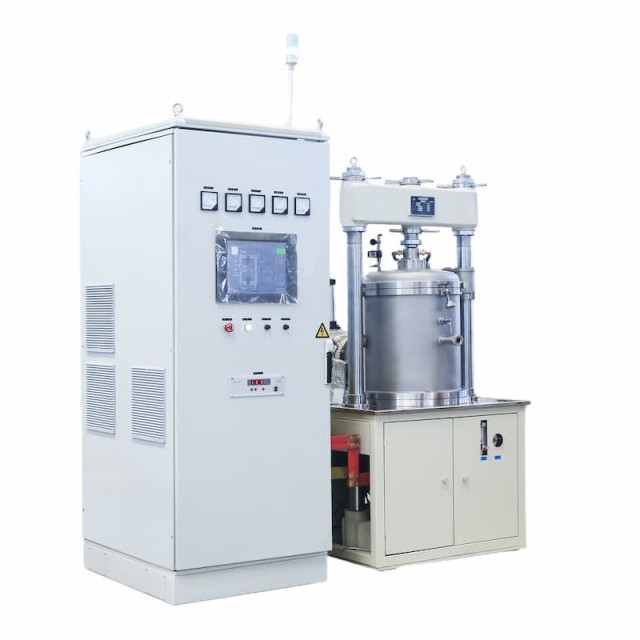
Vacuum Hot Press Furnace
Vacuum Hot Press Furnace Machine Heated Vacuum Press
Item Number : KT-VHP
Price varies based on specs and customizations
- Working temperature
- 1500℃ / 2200℃ (Max, atmosphere dependent)
- Working pressure
- 10-400T (Customizable up to 800T)
- Vacuum pressure
- Up to 6x10^-3Pa (Higher vacuum options available)
Shipping:
Contact us to get shipping details Enjoy On-time Dispatch Guarantee.
Why Choose Us
Reliable PartnerEasy ordering process, quality products, and dedicated support for your business success.
Leveraging exceptional R&D and in-house manufacturing, KINTEK provides diverse laboratories with advanced high-temperature furnace solutions. Our product line, including Muffle, Tube, Rotary Furnaces, Vacuum & Atmosphere Furnaces, and CVD/PECVD/MPCVD Systems, is complemented by our strong deep customization capability to precisely meet unique experimental requirements.
Introducing the KINTEK Vacuum Hot Pressing Furnace
At KINTEK, we understand the critical role of advanced material processing. Our Vacuum Hot Pressing Furnace is a state-of-the-art system meticulously designed to heat and pressurize materials under precisely controlled vacuum or atmospheric conditions. This process is key to achieving superior material density, enhanced mechanical properties, and overall improved performance for a wide range of applications. Whether you're working with metals, ceramics, or composite materials, our furnace provides the reliability and precision you need.
If you're looking for a furnace solution tailored to your unique experimental or production needs, KINTEK's deep customization capabilities can help. Contact us today to discuss your specific requirements.
Visual Showcase: Explore the Vacuum Hot Pressing Furnace
Get a closer look at the robust engineering and thoughtful design of our Vacuum Hot Pressing Furnace. The images below highlight its key components and overall structure.

Our Vacuum Hot Pressing Furnace is engineered for precision, durability, and ease of use. Key structural highlights include:
- Robust Furnace Body: A double-shell structure with a water-cooled jacket. The inner shell is made of finely polished stainless steel, ensuring a clean processing environment. Housings are constructed from high-quality carbon steel with anti-rust treatment or stainless steel with a pad blasted finish for longevity.
- Efficient Heating System: Utilizes graphite or molybdenum wire heating elements, configurable for 1-phase or 3-phase heating. The rational design of the heating element promotes uniform temperature distribution within the furnace cavity.
- Advanced Control System: The furnace is operated via a user-friendly electrical control system. Temperature and pressure can be managed by PLC analog control, or the entire sintering process can be automated using a temperature and pressure programmable controller. Comprehensive alarm and protection functions for water cut-off, over-temperature, and over-current are integrated for safe operation.
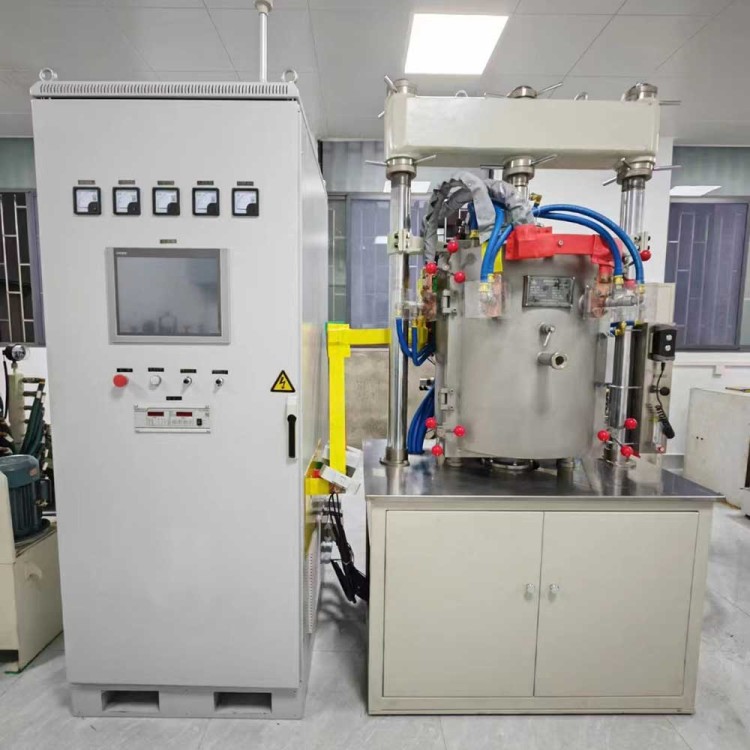
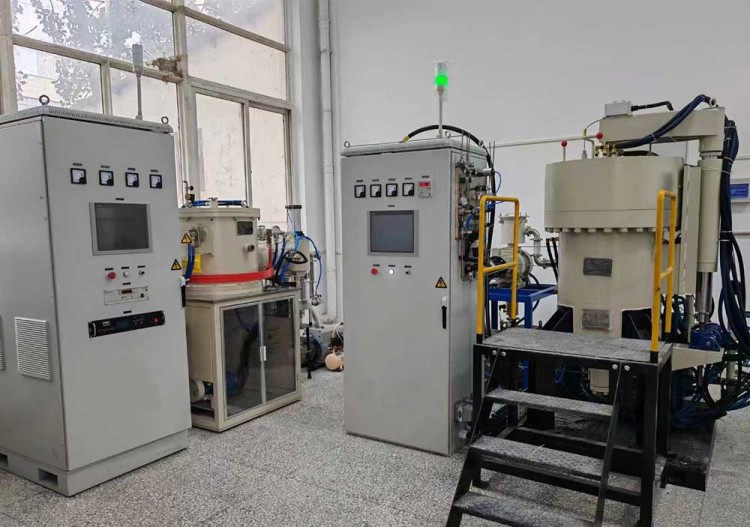
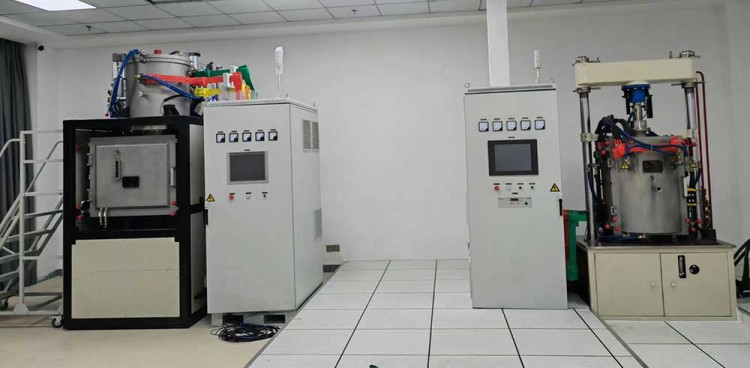

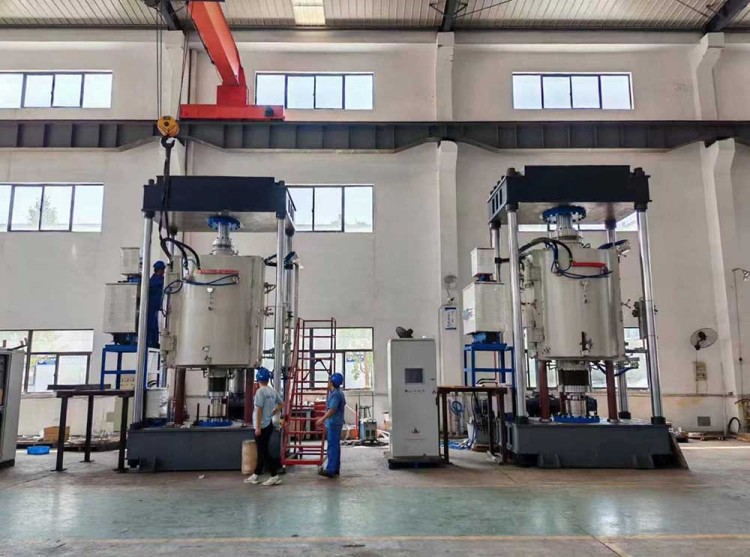
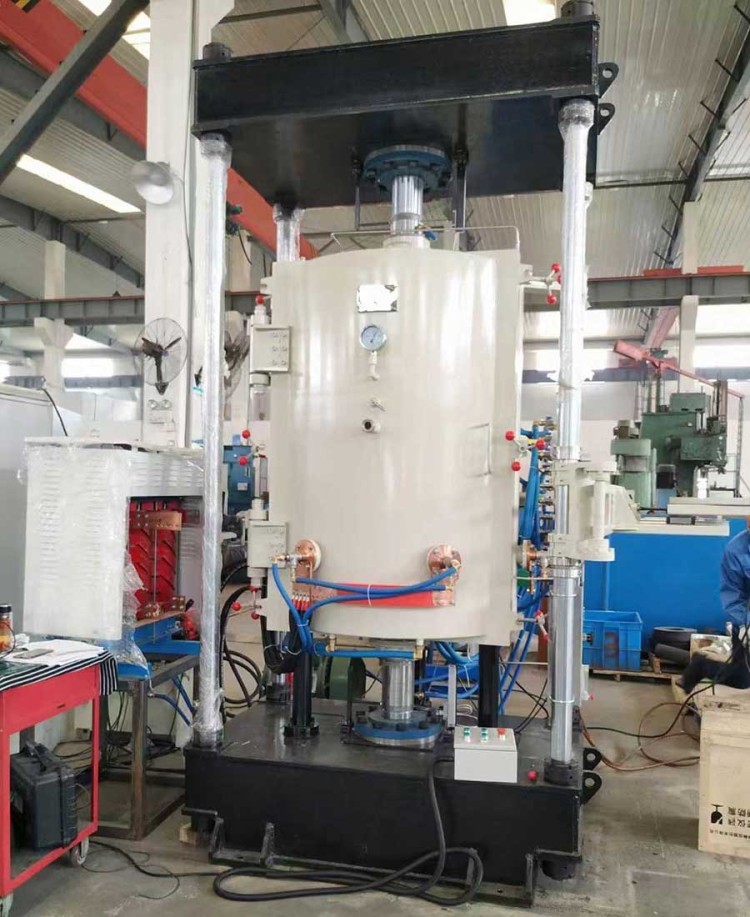

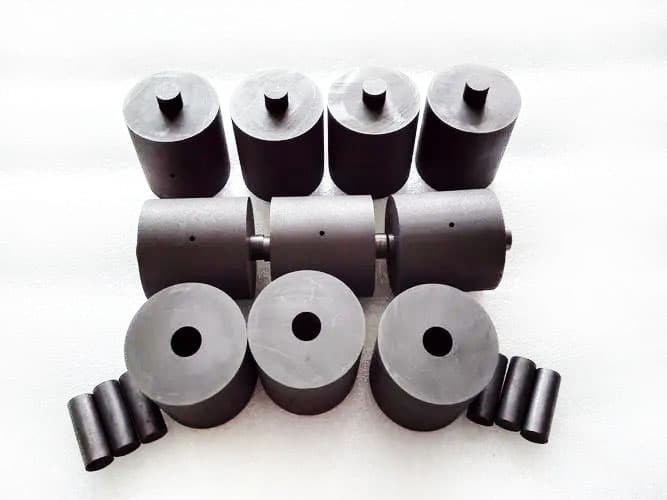
Understanding the Vacuum Hot Pressing Furnace: How It Works & What It Achieves
The KINTEK Vacuum Hot Pressing Furnace is a complete set of equipment meticulously engineered to simultaneously heat and pressurize materials within a vacuum or controlled atmosphere. This sophisticated process allows for:
- Precise Environmental Control: Depending on the material and desired outcome, heating elements can be graphite heaters, molybdenum heaters, or induction heating systems. Pressurization is achieved hydraulically and can be applied uni-directionally or bi-directionally.
- Material Transformation at the Microscopic Level: Under high temperature, high pressure, and the controlled environment (vacuum or atmosphere), raw material solid particles begin to bond with each other. This initiates grain growth, while voids (pores) and grain boundaries gradually diminish.
- Densification and Enhanced Properties: Through the transfer of materials during this process, the total volume of the material shrinks, and its density significantly increases. The result is a compact, polycrystalline sintered body with a specific, desirable microstructure. This transformation leads to a marked improvement in the density, hardness, and other crucial mechanical, electronic, and thermal properties of the finished materials.
By enabling such profound material changes, our Vacuum Hot Pressing Furnace empowers you to produce materials with superior characteristics, perfectly suited for demanding applications.
Key Benefits & Advanced Features: Why Choose Our KINTEK Furnace?
Our Vacuum Hot Pressing Furnace is engineered to deliver exceptional performance, reliability, and efficiency, providing significant value to your operations:
- Versatile Material Processing: Supports a wide array of heat treatment processes suitable for diverse materials (metal powders, inorganic non-metallic materials, etc.) and industries. Its multi-purpose design means it can also be used as a simple vacuum or atmosphere sintering furnace, ensuring adaptability to your evolving research or production needs.
- Efficient High-Speed Cycles: Can be designed to facilitate high-speed cycles, potentially including high-pressure gas quench features for rapid cooling, enabling faster turnaround times and boosting your productivity.
- Optimized Energy and Resource Use: Designed for low consumption of energy and process gases. Advanced thermal insulation materials with low thermal conductivity effectively isolate heat, reducing energy consumption and making it an environmentally conscious and cost-effective solution.
- Precision Control & Superior Results:
- Achieve consistent, high-quality outcomes with precise temperature and pressure regulation. Temperature control (up to 2800°C depending on heating element and atmosphere) and pressure are managed by imported brand program instruments and PLC, allowing for automated sintering processes based on preset programs.
- The rational design of heating elements (selectable from graphite, molybdenum, tungsten, induction heating) ensures uniform temperature distribution within the cavity for homogenous material processing.
- Robust and User-Friendly Design:
- Enhanced Durability and Temperature Stability: Features a double-layer SUS304 stainless steel vacuum chamber structure with a jacket cold water circulating cooling method to keep the furnace surface temperature low and ensure longevity.
- Stable and Precise Pressurization: A double-column supporting structure and a stable hydraulic press system allow for precise pressure regulation (manual or automatic control) and maintenance throughout the process.
- Simplified Operation & Maintenance: The intuitive electrical control system, with humanized configuration (manual/intelligent operation options), and a simple, modular design facilitate easy installation, operation, and maintenance.
- Customizable Vacuum System: Offers diversified vacuum system configurations (e.g., two-stage vacuum pumps, oil diffusion pump, and in-house designed high-vacuum baffle valves) to achieve various vacuum levels (e.g., down to 6x10-3Pa) tailored to your specific process requirements.
- Flexible Operational Capabilities:
- Accommodates hot pressing sintering in vacuum, inert atmosphere, or reducing atmosphere with a provided charging and discharging system.
- Offers diversified optional functional types, including vertical upper discharge, vertical side outlet discharge, one-way pressurization, and two-way pressurization to suit various experimental setups.
- Safety and Reliability: The control system includes comprehensive sound and light alarm functions for abnormal phenomena such as water cut-off, over-temperature, over-current, and thermocouple automatic switching failure. Predictive maintenance considerations contribute to minimal downtime and prolonged equipment lifespan.
Ready to optimize your material processing with these advanced features and achieve superior material properties? Get in touch with KINTEK to learn more or discuss your customization needs!
Versatile Applications Across Industries
The KINTEK Vacuum Hot Press Furnace is a versatile and powerful tool used across various industries for high-temperature processes. Its capability to operate in a vacuum or controlled atmosphere makes it particularly suited for applications requiring precise temperature control and a clean environment. Key application areas include:
- Crystal Growth: Ideal for the synthesis and growth of various types of crystals, crucial in the electronics and semiconductor industries.
- Advanced Heat Treatment: Used for the thermal processing of metals, alloys, and ceramics to enhance their mechanical properties, such as hardness, ductility, and strength.
- Thin Film Deposition Support: Can be integral in processes related to the manufacturing of electronic devices, solar cells, and optical coatings where densified substrates or targets are required.
- Materials Science Research: Widely used in laboratories for research and development of new materials, including advanced ceramics, composites, intermetallics, and superalloys.
- Powder Metallurgy: Essential for sintering and densifying metal powders and producing high-performance components.
- Electronics Manufacturing: Critical for processes like annealing, sintering of electronic components, and production of specialized electronic materials.
- Specialty Glass and Ceramics Manufacturing: Useful in the production of specialty glasses and ceramics, and the modification of their properties through controlled heat treatment and pressure.
- Production of Special Materials: Involved in the creation of materials with unique properties for demanding sectors like aerospace, defense, and medical devices.
- Academic and Research Institutions: A staple in university laboratories and research centers for advanced materials research, development, and small-scale production.
Detailed Structure & Components
Our electric furnace, available with graphite heating or resistance wire heating, is adept at sintering metal powder, inorganic non-metallic materials, and more under vacuum and high-temperature hot pressing conditions. It can also perform hot pressing sintering under a protective atmosphere, effectively promoting material densification, preventing deformation, and controlling grain size, especially for nanopowders.
| Overall Specification |
|
|---|---|
| Furnace Shell |
|
| Furnace Side Access & Monitoring |
|
| Heating Element |
|
| Insulation Layer |
|
| Vacuum System |
|
| Electric Control System Main Circuit |
|
Technical Specifications
| Working temperature | 1500℃ / 2200℃ (Max, atmosphere dependent) |
|---|---|
| Heating element | Molybdenum/Graphite (Other options like Tungsten, Induction available) |
| Working pressure | 10-400T (Customizable up to 800T) |
| Press distance | 100-200mm (Customizable) |
| Vacuum pressure | Up to 6x10-3Pa (Higher vacuum options available) |
| Effective working area diameter range | 90-600mm (Customizable) |
| Effective working area height range | 120-600mm (Customizable) |
Note: Specifications are customizable to meet specific experimental or production requirements.
Ready to Enhance Your Material Processing?
KINTEK's Vacuum Hot Pressing Furnace offers unparalleled precision, efficiency, and versatility for your advanced material processing needs. With our commitment to exceptional R&D, in-house manufacturing, and strong deep customization capabilities, we are dedicated to helping you achieve superior results and push the boundaries of material science.
Take the next step towards optimizing your experiments and production. Contact us today to discuss your specific requirements, request a detailed quote, or learn more about how our advanced furnace solutions can benefit your laboratory or facility. Let KINTEK be your partner in innovation!
FAQ
What Is A Vacuum Hot Press And How Does It Work?
What Are The Main Applications Of A Vacuum Furnace?
What Is The Principle Of A Hot Press Furnace?
What Is An Atmosphere Furnace Used For?
What Is The Principle Of A CVD Machine?
What Is A Vacuum Induction Furnace?
What Are The Main Applications Of A Horizontal Vacuum Furnace?
What Are The Main Components Of A Vacuum Hot Press?
What Are The Key Features Of A Vacuum Furnace?
What Are The Applications Of A Hot Press Furnace?
What Are The Key Features Of An Atmosphere Furnace?
What Are The Advantages Of Using A CVD Machine?
What Are The Main Applications Of Vacuum Induction Furnaces?
What Are The Key Features Of A Horizontal Vacuum Furnace?
What Are The Advantages Of Using A Vacuum Hot Press?
How Does A Vacuum Furnace Work?
What Are The Features Of A Hot Press Furnace?
How Does An Atmosphere Furnace Work?
What Are The Applications Of A CVD Machine?
How Does A Vacuum Induction Furnace Work?
How Does A Horizontal Vacuum Furnace Work?
What Industries Commonly Use Vacuum Hot Press Technology?
What Are The Advantages Of Using A Vacuum Furnace?
Why Is A Vacuum Environment Used In Hot Press Furnaces?
What Are The Advantages Of Using An Atmosphere Furnace?
What Are The Key Features Of A CVD Machine?
What Are The Advantages Of Using A Vacuum Induction Furnace?
What Are The Advantages Of Using A Horizontal Vacuum Furnace?
What Types Of Materials Can Be Processed In A Vacuum Hot Press?
What Types Of Materials Can Be Processed In A Vacuum Furnace?
What Materials Are Commonly Processed In Hot Press Furnaces?
What Types Of Gases Can Be Used In An Atmosphere Furnace?
What Types Of CVD Machines Are Available?
What Types Of Vacuum Induction Furnaces Are Available?
What Types Of Materials Can Be Processed In A Horizontal Vacuum Furnace?
What Temperature And Pressure Ranges Can Vacuum Hot Presses Achieve?
What Is The Difference Between Hot Wall And Cold Wall Vacuum Furnaces?
What Safety Features Are Available In Advanced Atmosphere Furnaces?
Why Is Temperature Control Important In Vacuum Induction Furnaces?
What Is The Temperature Range Of A Horizontal Vacuum Furnace?
What Are Some Common Applications Of Vacuum Hot Pressing?
Can Vacuum Furnaces Be Customized For Specific Applications?
What Materials Can Be Processed In A Vacuum Induction Furnace?
How Does The Vacuum Environment Benefit Material Processing?
4.8
out of
5
Incredible precision and speed! This machine exceeded all my expectations.
4.9
out of
5
Top-notch quality and durability. Worth every penny!
4.7
out of
5
Fast delivery and easy setup. A game-changer for my lab!
4.9
out of
5
The technological advancement in this machine is mind-blowing. Highly recommend!
4.8
out of
5
Superior performance and reliability. Perfect for high-precision tasks.
4.7
out of
5
Efficient and robust. Delivered faster than expected!
4.9
out of
5
Exceptional value for money. The quality is unmatched.
4.8
out of
5
A stellar addition to our workshop. Works flawlessly every time.
4.9
out of
5
Innovative design and outstanding performance. Love it!
4.7
out of
5
Reliable and durable. Perfect for industrial applications.
4.8
out of
5
Quick delivery and excellent customer service. The machine is a beast!
4.9
out of
5
Precision engineering at its best. Highly efficient and durable.
4.8
out of
5
Cutting-edge technology. Makes my work so much easier!
4.7
out of
5
Fantastic build quality. Delivered in perfect condition.
4.9
out of
5
A must-have for any serious lab. Performance is outstanding.
4.8
out of
5
Super fast and efficient. The best investment we've made.
4.9
out of
5
Unbeatable quality and precision. Delivered ahead of schedule!
4.7
out of
5
Highly advanced and reliable. Perfect for our research needs.
4.8
out of
5
Exceptional machine with flawless performance. Very impressed!
4.9
out of
5
Worth every cent! The machine is a powerhouse of efficiency.
REQUEST A QUOTE
Our professional team will reply to you within one business day. Please feel free to contact us!
Related Products

Vacuum Hot Press Furnace Machine Heated Vacuum Press Tube Furnace
Discover KINTEK's advanced Vacuum Tube Hot Press Furnace for precise high-temperature sintering, hot pressing, and material bonding. Customizable solutions for labs.

Vacuum Hot Press Furnace Machine for Lamination and Heating
KINTEK Vacuum Lamination Press: Precision bonding for wafer, thin-film & LCP applications. 500°C max temp, 20-ton pressure, CE certified. Custom solutions available.

600T Vacuum Induction Hot Press Vacuum Heat Treat and Sintering Furnace
600T Vacuum Induction Hot Press Furnace for precise sintering. Advanced 600T pressure, 2200°C heating, vacuum/atmosphere control. Ideal for research & production.

Small Vacuum Heat Treat and Tungsten Wire Sintering Furnace
Compact vacuum tungsten wire sintering furnace for labs. Precise, mobile design with superior vacuum integrity. Ideal for advanced material research. Contact us!

9MPa Air Pressure Vacuum Heat Treat and Sintering Furnace
Achieve superior ceramic densification with KINTEK's advanced air pressure sintering furnace. High-pressure up to 9MPa, precise 2200℃ control.

Vacuum Heat Treat Sintering and Brazing Furnace
KINTEK Vacuum Brazing Furnaces deliver precision, clean joints with superior temperature control. Customizable for diverse metals, ideal for aerospace, medical, and thermal applications. Get a quote!

Vacuum Heat Treat Furnace with Ceramic Fiber Liner
KINTEK's Vacuum Furnace with Ceramic Fiber Lining offers precise high-temperature processing up to 1700°C, ensuring uniform heat distribution and energy efficiency. Ideal for labs and production.

Molybdenum Vacuum Heat Treat Furnace
High-performance molybdenum vacuum furnace for precise 1400°C heat treatment. Ideal for sintering, brazing, and crystal growth. Durable, efficient, and customizable.
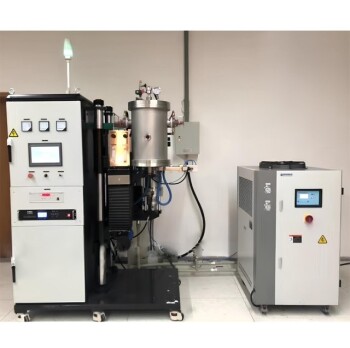
Vacuum Heat Treat Sintering Furnace Molybdenum Wire Vacuum Sintering Furnace
KINTEK's Vacuum Molybdenum Wire Sintering Furnace excels in high-temperature, high-vacuum processes for sintering, annealing, and material research. Achieve precise 1700°C heating with uniform results. Custom solutions available.

Vacuum Heat Treat Sintering Furnace with Pressure for Vacuum Sintering
KINTEK's Vacuum Pressure Sintering Furnace offers 2100℃ precision for ceramics, metals, and composites. Customizable, high-performance, and contamination-free. Get a quote now!

Dental Porcelain Zirconia Sintering Ceramic Vacuum Press Furnace
Precision Vacuum Press Furnace for labs: ±1°C accuracy, 1200°C max, customizable solutions. Boost research efficiency today!

High Pressure Laboratory Vacuum Tube Furnace Quartz Tubular Furnace
KINTEK High Pressure Tube Furnace: Precision heating up to 1100°C with 15Mpa pressure control. Ideal for sintering, crystal growth, and lab research. Customizable solutions available.
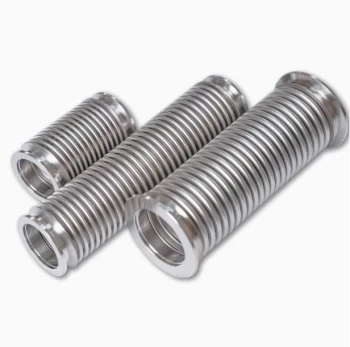
High Performance Vacuum Bellows for Efficient Connection and Stable Vacuum in Systems
KF ultra-high vacuum observation window with high borosilicate glass for clear viewing in demanding 10^-9 Torr environments. Durable 304 stainless steel flange.
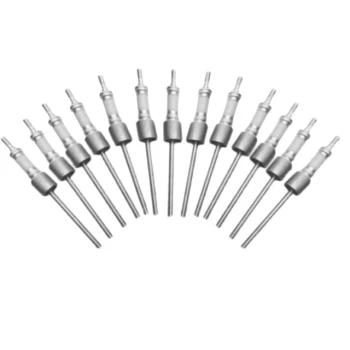
Ultra Vacuum Electrode Feedthrough Connector Flange Power Lead for High Precision Applications
Ultra-Vacuum Electrode Feedthroughs for reliable UHV connections. High-sealing, customizable flange options, ideal for semiconductor & space applications.
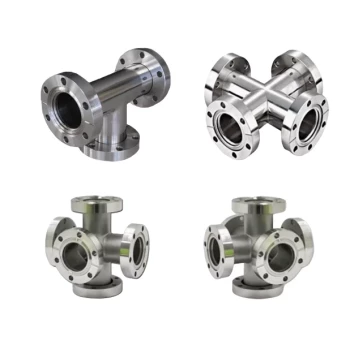
Ultra High Vacuum Stainless Steel KF ISO CF Flange Pipe Straight Pipe Tee Cross Fitting
KF/ISO/CF ultra-high vacuum stainless steel flange pipe systems for precision applications. Customizable, durable, and leak-tight. Get expert solutions now!

1400℃ High Temperature Laboratory Tube Furnace with Quartz and Alumina Tube
KINTEK's Tube Furnace with Alumina Tube: Precision high-temperature processing up to 2000°C for labs. Ideal for material synthesis, CVD, and sintering. Customizable options available.

1700℃ High Temperature Laboratory Tube Furnace with Quartz or Alumina Tube
KINTEK's Tube Furnace with Alumina Tube: Precision heating up to 1700°C for material synthesis, CVD, and sintering. Compact, customizable, and vacuum-ready. Explore now!
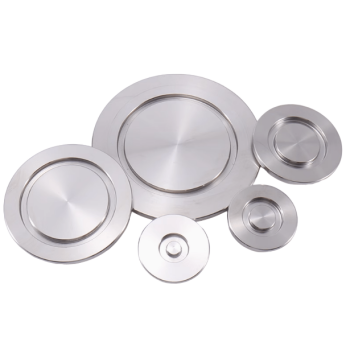
Stainless Steel KF ISO Vacuum Flange Blind Plate for High Vacuum Systems
Premium KF/ISO stainless steel vacuum blind plates for high-vacuum systems. Durable 304/316 SS, Viton/EPDM seals. KF & ISO connections. Get expert advice now!

2200 ℃ Tungsten Vacuum Heat Treat and Sintering Furnace
2200°C Tungsten Vacuum Furnace for high-temperature materials processing. Precise control, superior vacuum, customizable solutions. Ideal for research & industrial applications.
Related Articles

How Vacuum Hot Press Furnaces Transform Advanced Material Engineering
Vacuum hot press furnaces enable precise material synthesis for aerospace, electronics, and energy sectors, enhancing density, strength, and reliability.

Why Your High-Temperature Materials Fail: The Hidden War Inside Your Furnace
Discover why your hot-press experiments yield inconsistent results. It's not your settings—it's a hidden chemical reaction contaminating your samples.

Beyond the Parts List: The Real Reason Your Vacuum Hot Press Fails (And How to Fix It)
Frustrated with inconsistent vacuum hot press results? Discover why just upgrading parts fails and how a system-based approach unlocks repeatable success.

How to Select the Right Vacuum Hot Pressing Furnace Temperature for Your Materials
Learn how to choose the right vacuum hot pressing furnace temperature for materials like ceramics, metals, and alloys. Optimize sintering with expert tips.

Why Your Sintered Parts Fail: It’s Not Just About Heat, But Pressure and Purity
Struggling with porous, weak, or contaminated sintered materials? Discover why simply raising the temperature isn't the answer and how the interplay of heat, pressure, and vacuum is the key.

How Vacuum Pressure Sintering Furnaces Elevate Material Performance Across Industries
Discover how vacuum pressure sintering furnaces enhance material performance with precision, purity, and industry-specific benefits across aerospace, medical, and automotive sectors.

Your Vacuum Furnace Is a System, Not a Component—Here’s Why That Changes Everything
Struggling with inconsistent high-temperature vacuum processes? Discover why a bigger pump isn't the answer and how an integrated system approach is key.

Your Furnace Reached Temperature. So Why Did Your Experiment Fail?
Discover the hidden reason your high-temperature vacuum experiments fail despite hitting specs. Learn how heating element choice impacts purity and success.

The Real Reason Your High-Performance Materials Are Failing (And It’s Not the Alloy)
Tired of inconsistent heat treatment? Discover the two invisible culprits sabotaging your materials and how a vacuum furnace provides the control to fix it for good.

Why Your High-Purity Metals Oxidize in a Perfect Vacuum—And How to Stop It
Frustrated by oxidized metals from your vacuum furnace? Discover the real culprit isn't the vacuum but the cooling phase, and how to fix it.

Why Your High-Precision Parts Warp—And How to Stop It for Good
Struggling with part distortion in high-precision assemblies? Discover the root cause—thermal gradients—and how vacuum brazing provides the definitive solution.

Why Your Vacuum Furnace Failed After the Lab Move—And How to Prevent It
Discover why vacuum furnaces often fail after being moved and how robust engineering prevents costly damage to seals and components. Protect your investment.